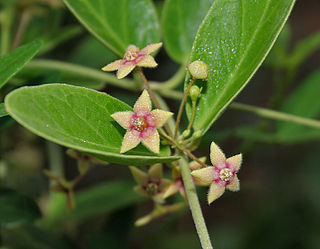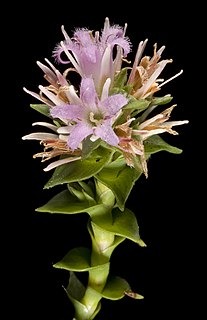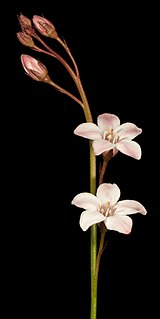
Eucalyptus microcorys, commonly known as tallowwood, is a species of medium to tall tree that is endemic to eastern Australia. It has rough, fibrous or string bark on the trunk and branches, lance-shaped to egg-shaped adult leaves, flower buds in groups of seven or nine, white to lemon-yellow flowers and conical fruit. It grows in forests near the coast of Queensland and New South Wales.

Banksia armata var. armata is a variety of shrub that is endemic to Western Australia. It differs from the other variety in having a lignotuber, narrower leaves with more sides lobes and shorter flowers. It is also usually a shorter plant.
Prodromus Florae Novae Hollandiae et Insulae Van Diemen is a flora of Australia written by botanist Robert Brown and published in 1810. Often referred to as Prodromus Flora Novae Hollandiae, or by its standard botanical abbreviation Prodr. Fl. Nov. Holland., it was the first attempt at a survey of the Australian flora. It described over 2040 species, over half of which were published for the first time.
Robert Brown's taxonomic arrangement of Dryandra was the first arrangement of what is now Banksia ser. Dryandra. His initial arrangement was published in 1810, and a further arrangement, including an infrageneric classification, followed in 1830. Aspects of Brown's arrangements can be recognised in the later arrangements of George Bentham and Alex George.

Tylophora is a genus of climbing plant or vine, first described as a genus in 1810. It is native to tropical and subtropical Asia, Africa, and Australia. Most of the species are perennial lianas. The name is derived from the Ancient Greek tylos/τυλος "knot", and phoros/φορος "bearing". The genus was originally erected by Robert Brown for four species he described in Australia. It was placed in the Asclepiadaceae, which has now been sunk into Apocynaceae.

Spinifex longifolius, commonly known as beach spinifex, is a perennial grass that grows in sandy regions along the seacoast. It also lives in most deserts around Australia.

Dryandra subg. Hemiclidia is an obsolete plant taxon that encompassed material that is now included in Banksia. Published at genus rank as Hemiclidia by Robert Brown in 1830, it was set aside by George Bentham in 1870, but reinstated at subgenus rank by Alex George in 1996. In 2007, all Dryandra species were transferred into Banksia at series rank, and the infrageneric Dryandra taxa, including D. subg. Hemiclidia, were set aside.

Hemigenia is a genus of flowering plants in the mint family, Lamiaceae and is endemic to Australia where most species occur in Western Australia, although some are also found in New South Wales and Queensland. Plants in this genus are shrubs or bushes with simple leaves and tube-shaped flowers with the petals forming two "lips" - the upper one with two lobes and the lower one with three.
Xerochloa is a genus of Australian and Southeast Asian plants in the grass family.

Dianella revoluta, commonly known as blueberry lily, blue flax-lily, or black-anther flax-lily, a species of flowering plant in the family Asphodelaceae and is endemic to, and widespread in Australia. It is a tufted, perennial herb with grass-like leaves and up to nine blue or violet flowers with six tepals, and stamens with bright yellow filaments and pale brown to almost black anthers.

Andersonia sprengelioides is a species of shrub that grows in the south west corner of Western Australia. It was originally described by the botanist Robert Brown in 1810 and retains its original name. The genus Andersonia is classified in the Ericaceae, or in the family Epacridaceae.

Andersonia is a genus of small evergreen shrubs in the family Ericaceae. The genus is endemic to the Southwest Botanical Province in Western Australia.

Isopogon trilobus, commonly known as barrel coneflower, is a species of flowering plant in the family Proteaceae and is endemic to South Coast Western Australia. It is a shrub with wedge-shaped leaves with lobed or toothed leaves, and oval, spherical or barrel-shaped heads of cream-coloured to yellow flowers.
Tylophora barbata, the Bearded Tylophora, is a small vine in the dogbane family. A common plant found south of Bulahdelah, New South Wales. The habitat is rainforest and moist eucalyptus forests in south eastern Australia. Not often seen in flower, but flowers are dark red, around 7 mm long on thin stalks. Broken branches produce watery or milky sap.

Persoonia laurina, commonly known as the laurel-leaved or laurel geebung, is a shrub of the family Proteaceae native to central New South Wales in eastern Australia. Found in sclerophyll forest, it grows to a height of 2 metres. The yellow flowers appear in late spring.

Microcorys is a genus of flowering plants in the family Lamiaceae, first described in 1810. The entire genus is endemic to Australia.
- Microcorys barbataR.Br. - Western Australia
- Microcorys boxwoodNewbey - Western Australia
- Microcorys capitata(Bartl.) Benth. - Western Australia
- Microcorys cephalanthaB.J.Conn - Western Australia
- Microcorys ellipticaB.J.Conn - Northern Territory
- Microcorys eremophiloidesKenneally - Western Australia
- Microcorys ericifoliaBenth. - Western Australia
- Microcorys exsertaBenth. - Western Australia
- Microcorys glabra(Bartl.) Benth. - Western Australia
- Microcorys lenticularisF.Muell. - Western Australia
- Microcorys loganiaceaF.Muell. - Western Australia
- Microcorys longifloraF.Muell. - Western Australia
- Microcorys longifolia(Benth.) Benth. - Western Australia
- Microcorys macredieanaF.Muell. - Northern Territory
- Microcorys obovataBenth. - Western Australia
- Microcorys pimeloidesF.Muell. - Western Australia
- Microcorys purpureaR.Br. - Western Australia
- Microcorys queenslandicaC.T.White - Queensland
- Microcorys subcanescensBenth. - Western Australia
- Microcorys tenuifoliaBenth. - Western Australia
- Microcorys virgataR.Br. - Western Australia
- Microcorys wilsonianaB.J.Conn - Western Australia

Isopogon longifolius is a small shrub in the family Proteaceae that is endemic to the southwest of Western Australia.
Anarthria scabra is an herbaceous plant found in Southwest Australia.

Leucopogon gracilis is a shrub in the family Ericaceae found in Western Australia.

Samolus junceus in the family Primulaceae is a species of water pimpernel native to Western Australia.
















